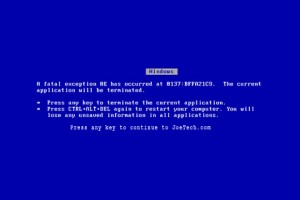
It’s summer. As the mercury slides up the thermometer (WAY up the thermometer), several events in the archaeological yearly round appear on the horizon. A host of field schools are in full swing around the globe, anxious graduate students are working to complete fieldwork before returning to the classroom, and there is the usual crop of CRM projects that tax the sweat glands and keep sports drink companies in the black.
For those of us exploring the academic job market, this also means that a new round of position announcements lies on the horizon. For each position, a lucky few candidates will get invited to a campus visit, which will entail a job talk.
The job talk can be an intimidating, highly daunting experience. This post is intended to offer some basic guidance that may assist the prospective with preparing for this talk. I draw upon some printed and electronic sources (there frankly aren’t many available on this subject) as well as some interviews with several scholars who have gone through this process recently and met with success.
Do Your Homework
It should come as no surprise that there is a lot of planning involved in the job talk. Think about who is going to be in the room. If you will be presenting at a large university with a graduate program, you can expect faculty, graduate students, and some upper-division undergraduates. With many departmental web pages now carrying faculty photographs, it’s not a bad idea to be able to identify the faculty on sight, which can help you anticipate queries during the Q and A after the talk and anticipate some of the questions that might be posed to you.
In most departments, the attendees are likely to be at least conversant in the elements of archaeology, though may not be as familiar with historical archaeology, and almost certainly not with your particular focus within historical archaeology, so be prepared to walk them along to the point that you can convey the import of your work. James Davidson, of the University of Florida, suggests that avoiding excessive particularlism can help the candidate show how well-rounded he or she is.
Anna Agbe-Davies (University of North Carolina) points out that as historical archaeologists, we straddle a lot of disciplines, meaning that we might wind up teaching in anthropology, history, or American studies departments, each of which will be more or less familiar with your discipline. It is possible that 75% of the audience may have no meaningful understanding of archaeology, and would therefore need more background than a department crammed full of diggers.
If you don’t do this well, you can expect to get questions on the technical aspects of the work only, and you likely lose the chance to have a substantive discussion of what you just presented. You also want to avoid coming off as interested in an arcane corner of the scholarly world. It’s easy to forget how niche your work is when you’re writing the dissertation. Showing the relevance of your work to larger trends in academic thought, within as well as outside of archaeology, is generally a good thing.
Time and Message Discipline: These are a Few of My Favorite Things
Most of the job talks I’ve attended were allocated an hour. You know what happens at the end of that hour, right? People start looking towards the door, ready to leave. If you talk right up to that hour mark, your audience won’t get to ask questions or will have to stay late, which won’t make you look good to a prospective employer.
Darley and Zannah (1986) suggest that it’s best to take about 75% of the allotted time for your talk. For an hour, this would be about 45 minutes, which is long enough to get to the meaty bits of your research, but not so long that you start unduly taxing people’s attention spans. This will leave a nice amount of room for questions, which there will be (see Practice, Practice, Practice, below). Be sure to check with the host institution before you start planning the talk to make sure you know long you have.
Also, keep on message (avoid ramblings and digressions) and keep an eye on the clock (wear a wristwatch in case there’s not a visible clock in the room). These kinds of discipline are crucial to show that you can organize your talk into a digestible, relatable way. Hit the high points.
The Army* encourages presentations (OK, briefings, but they’re basically the same thing) to consist of three major points, each supported by three subsidiary points. While that structure isn’t going to suit everyone, the idea behind that structure is to present the most crucial elements of the material in a fulsome, but necessarily limited manner, as you don’t have the time and your audience doesn’t have the attention span to ingest all the details of your work.
Technology
Let’s envision a scenario wherein you’re setting up for your job talk at Awesome State University (Go Fighting Crawfish!). You’ve spent the past week constructing what could be empirically verified as the greatest PowerPoint presentation in history. It interdigitates flawlessly with your job talk, the images and data tables tagging off brilliantly with the speech you’re about to give. The recording of the talk (it will probably be recorded) will play on a continuous loop in the Louvre next to the Mona Lisa.
You clear your throat, approach the podium, and you get through exactly five letters (“Welco…”) before a pop and hiss signifies the untimely demise of the bulb in the projector… that is affixed to the ceiling of the classroom… fifteen feet above the audience and reachable only by ladder. There’s no chance that bulb gets replaced anytime tonight, and you must now do your presentation without the aid of visuals (I would not advise trying to compensate by doing shadow puppets with a flashlight).

We’ve all seen this kind of thing happen at conferences. Not so long ago, the slide projector might spit the carousel, or a slide would be in backwards. Nowadays, it might be that the available computer runs OpenOffice or something else not-PowerPoint, and the formatting goes haywire. We can laugh that off because a conference presentation is not a job talk.
This is. Buller (2010:21) observes that candidates can derail their chances for being offered a job by placing their faith in unreliable technology. Never assume that a certain kind of technology will be available, and be prepared for malfunctions. Always take several different formats of your presentation. At minimum, have a laptop with you that has your presentation deck saved on it. Carry additional copies on a flash drive and a CD/DVD (have cuneiform tablets gone out of style yet?). Get these together BEFORE you leave town for the campus visit, as you can’t rely on having the time to make the requisite copies.
I’ll include one other thing that cropped up recently with a colleague’s laptop as she started teaching a class here at Southern Arkansas University. Her brand-new laptop didn’t come with a VGA port. That’s the 15-hole connector on the side of most laptops. Since most folks never use the VGA port, the manufacturer left it out, requiring a special adapter (“dongle”) to add that functionality. Better to find that out before you get in the room to give your talk.
At the most extreme, be prepared to give your talk completely sans power/technology. Buller recommends carrying printouts of essential images or data tables to pass around, should the technology completely fail you. If everything goes smoothly and you don’t need them, they make useful handouts that you can pass along to interested parties at the close of the talk, or useful aids to those with failing eyesight who might have trouble seeing your presentation slides from the audience.
Practice, Practice, Practice (then Practice Some More… and between Practices, Work in Some Practice)
Darley and Zanna (1986) describe the job talk as essentially a performance. Like any play or musical, rehearsal breeds quality and coherence. Know the talk cold. Be able to present it in 16 different languages, and be able to present it backwards in at least 9. Have friends shoot you with paintballs at random while rehearsing so you can practice recovering should you be knocked off your rhythm.
Agbe-Davies suggests that, if you’re a graduate student, get your peer grads together to watch a dry run of your talk. Graduate students can be some of the harshest critics of your work, much more so than faculty, and their comments (politely phrased) can help you anticipate questions that could crop up at the actual job talk or point out shortcomings that you could revise into a subsequent draft of the talk.
Don’t Panic, and Always Carry a Towel
OK, not really. Well, do indeed refrain from panicking, but a towel is not necessary. See Adams (1979) for disambiguation.
If you haven’t sat through job talks at your own institution before, be warned that they can become somewhat tense. Resident faculty may ask some hard, sometimes harsh, questions of the candidate. This is not necessarily intended to expose the speaker’s shortcomings as a scholar, though it might. It could, rather, be a test of the speaker’s ability to carry on rigorous academic debate. One’s ability to match wits with the department’s faculty can significantly add to a candidate’s standing. Matt Liebmann, of Harvard University, encourages us to “NEVER apologize for your work,” and that one’s inclination, when challenged by established faculty, is to become apologetic for its shortcomings. “Deliver your talk with confidence and always stand up for yourself during the question and answer section” (Liebmann, personal communication).
But, don’t fret. You’re not going to anticipate EVERY question, and there is likely going to be something asked that you just don’t have an answer for. Admit that you don’t know, thank the questioner for providing new light on the subject, and write down the question. Whether you get the job or not, you have something to consider in your own scholarship in future. If you have a later job talk elsewhere, you have a chance to prepare for that question, should it come up again. It also shows that you’re engaged with the audience and having a professional discussion with them.
Do you have other thoughts or insights? Post them in the comments section.
Thanks to Dr. Anna Agbe-Davies (University of North Carolina), Dr. James Davidson (University of Florida), and Dr. Matthew Liebmann (Harvard University) for providing insight and reflections on their experience of this process. The above is my recalling and interpretation of their remarks, and I take full responsibility for any mischaracterizations, etc.
References
- Adams, Douglas
- 1979 The Hitchhiker’s Guide to the Galaxy. New York: Harmony Books.
- Buller, Jeffrey L.
- 2010 The Essential College Professor: A Practical Guide to an Academic Career. San Francisco: John Wiley & Sons.
- Darley, John M. and Mark P. Zanna
- 1986 The Compleat Academic: A Career Guide. New York: Random House.

